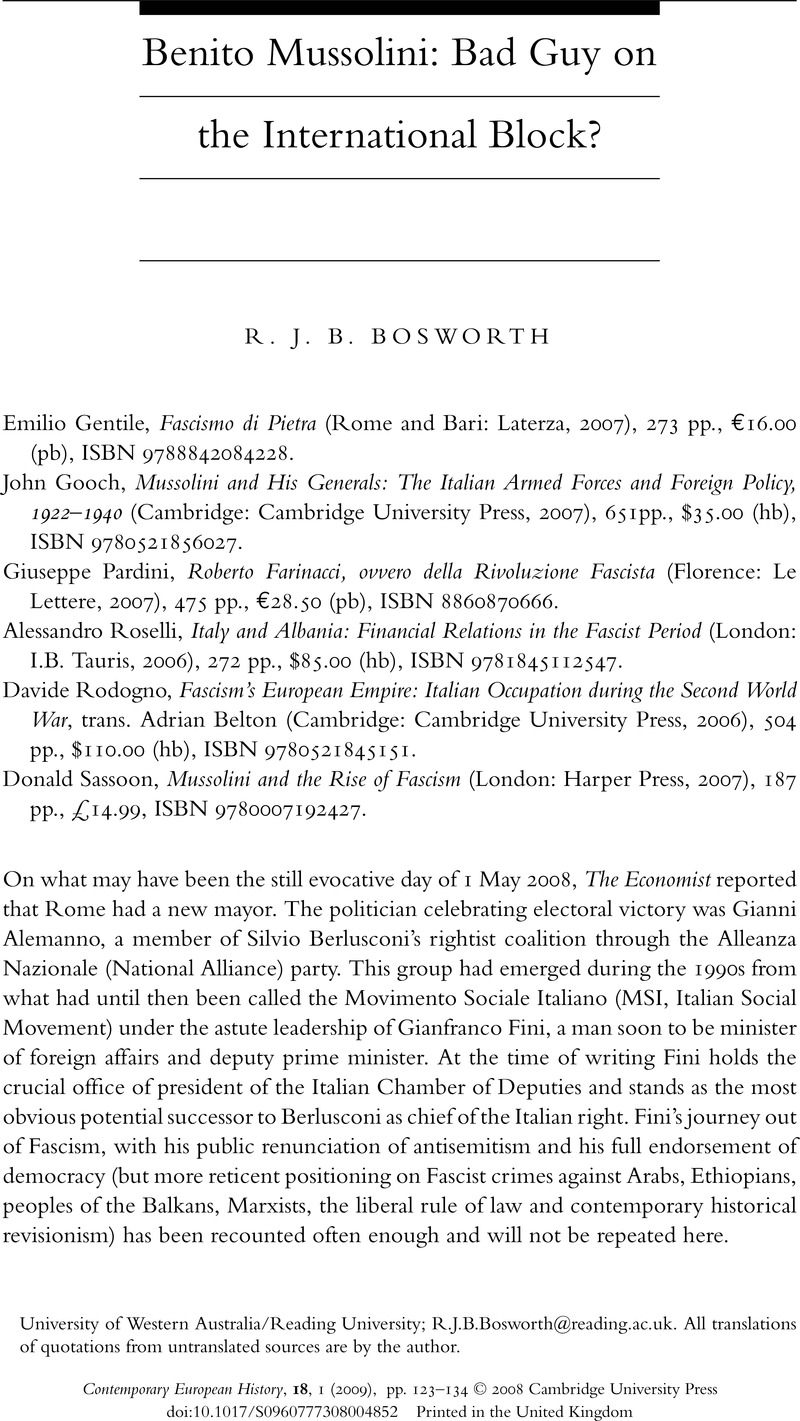No CrossRef data available.
Article contents
Benito Mussolini: Bad Guy on the International Block?
Published online by Cambridge University Press: 01 February 2009
Abstract

- Type
- Review Article
- Information
- Copyright
- Copyright © Cambridge University Press 2008
References
1 Rauti, G., L'immane conflitto. Mussolini, Roosevelt, Stalin, Churchill, Hitler (Rome: Centro editoriale nazionale, 1966), 14–15Google Scholar.
2 Ibid., 190–1.
3 Festorazzi, R., Starace: il mastino della Rivoluzione Fascista (Milan: Mursia, 2002), 10Google Scholar. Mursia continues to specialise in publishing such revisionist works.
4 Farinacci's plagiarism of his law thesis is admitted but explained away by Pardini with Farinacci's own line that the matter was then not a crime but rather was quite a habit in Italy (see Pardini, Roberto Farinacci, 118 n., 306).
5 For one example see Lucifero, F., L'ultimo re: i diari del ministro della Real Casa 1944–1946, ed. Lucifero, A and Perfetti, F. (Milan: Mondadori, 2002)Google Scholar, where Perfetti, in his introduction (xxxi–xxxii), hints that a monarchist victory might have been stolen by republicans during the poll in June 1946.
6 For the intellectual and sociological background, see Bosworth, R. J. B., The Italian Dictatorship: Problems and Perspectives in the Interpretation of Mussolini and Fascism (London: Arnold, 1999)Google Scholar.
7 For his own pietas to his predecessor, see Gentile, E., Renzo De Felice: lo storico e il personaggio (Rome and Bari: Laterza, 2003)Google Scholar.
8 English-speaking readers might like to compare Painter, B., Mussolini's Rome: Rebuilding the Eternal City (New York: Palgrave Macmillan, 2005)CrossRefGoogle Scholar, which is not dissimilar in its argument.
9 For an account of the specificities of the area around San Lorenzo, destined to be bombed in July 1943, see Piccioni, L., San Lorenzo: un quartiere romano durante il fascismo (Rome: Edizioni di Storia e Letteratura, 1984)Google Scholar.
10 For a lively example see Finaldi, G., Mussolini and Italian Fascism (Harlow: Pearson, 2008)Google Scholar.
11 The brevity of this work is a striking contrast to the massive Sassoon, D., The Culture of Europeans (New York: HarperCollins, 2006)Google Scholar.
12 The gap between English-language-speaking and Italian interpretation of Fascist diplomacy may be enhanced by the presence of Francesco Perfetti as academic head of the archives of the Italian ministry of foreign affairs.
13 Knox, M., To the Threshold of Power, 1922/33: Origins and Dynamics of the Fascist and National Socialist Dictatorships (Cambridge: Cambridge University Press, 2007), 131CrossRefGoogle Scholar.
14 Ibid., 50, 57.
15 Ibid., 302–4.
16 Ibid., 371.
17 Ibid., 384.
18 See Knox, M., Mussolini Unleashed 1939–1941: Politics and Strategy in Fascist Italy's Last War (Cambridge: Cambridge University Press, 1982)CrossRefGoogle Scholar; Hitler's Italian Allies: Royal Armed Forces, Fascist Regime, and the War of 1940–1943 (Cambridge: Cambridge University Press, 2000); Common Destiny: Dictatorship, Foreign Policy, and War in Fascist Italy and Nazi Germany (Cambridge: Cambridge University Press, 2000).
19 There is a major new biography of Italy's ambitious Liberal foreign minister, Antonino Di San Giuliano, 1910–1914, a man with deep interest in Albania and an important figure in any assessment of the continuity of Italian expansionist hopes. See Ferraiolo, G., Politica e diplomazia in Italia tra XIX e XX secolo. Vita di Antonino di San Giuliano 1852–1914 (Rome: Rubbettino, 2007)Google Scholar.
20 In this instance, Cambridge University Press has not done well with its translator, and readers with Italian will prefer the original: Rodogno, D., Il Nuovo Ordine Mediterraneo: le politiche di occupazione dell'Italia fascista in Europa (1940–1943) (Turin: Bollati Boringhieri, 2003)Google Scholar.
21 Pavone, C., Una guerra civile: saggio storico sulla moralità nella Resistenza (Turin: Bollati Boringhieri, 1991)Google Scholar.
22 General Mario Roatta's note ‘3C’ of 1 March 1942 confirmed this vicious racism (pp. 335–8).
23 Cf. Steinberg, J., All or Nothing: The Axis and the Holocaust 1941–1943 (London: Routledge 1993)Google Scholar.




